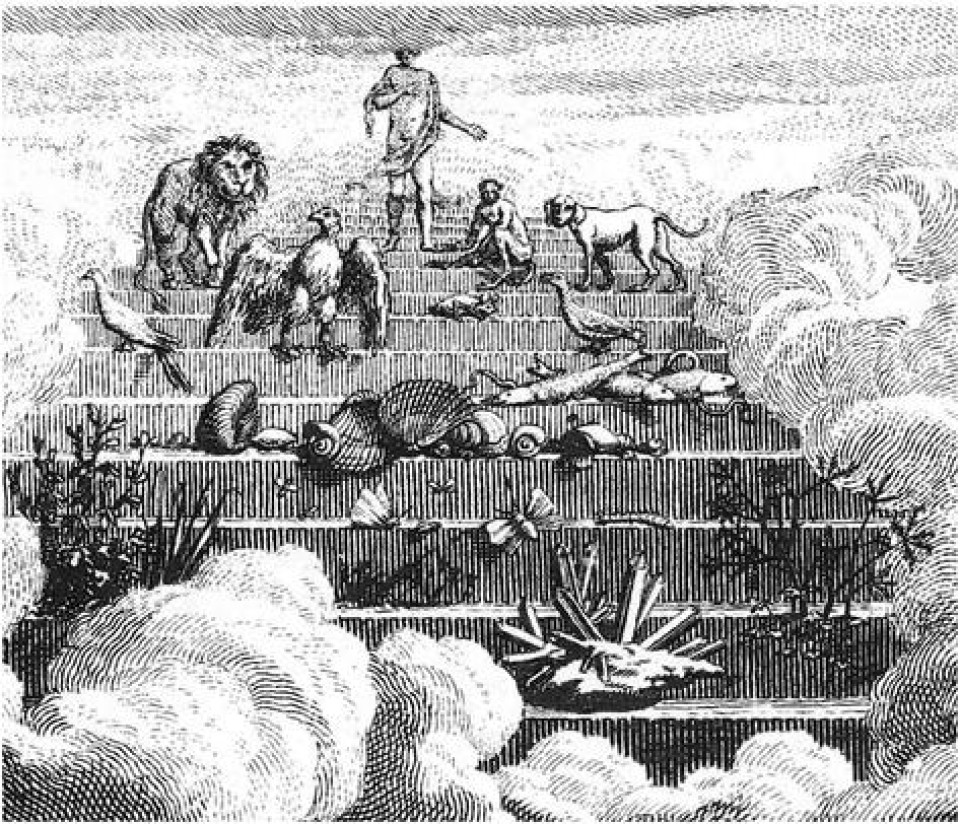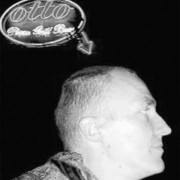Design in the Chain of Being
The notion of the Anthropocene acknowledges the impact of human civilization and capitalism on the planet, yet the “anthro” in the title also reaffirms the human position as the dark ruler of the planet. Not only have designers played a key role in producing the dark conditions of the unsustainable conditions of consumer society, but design as a paradigm of production is explicitly anthropocentric and elitist: the whole cycle of life on the planet serves the top of the chain – humanity.
Designers habitually keep reproducing the metaphysical order or hierarchies in the universe, or The Great Chain of Being or scala naturæ, a conceptual model with pervasive influence on Western thought. For Aristotle and later medieval thinkers this model, ordering the universe from the most basic up to the very highest and most perfect being, merged early scientific ideas of order with theological and philosophical ideals, merging physics with morals, biology with cosmology.
The Chain is the order of the universe, where all being is continuous and graded. The basic forms have body, while higher forms have life. Simple life can reproduce, while higher life forms have movement, sense and memory, up to the soul and reason, peaking at the ideal of God. Thus, at the bottom are minerals with no life, then comes plant with reproduction, then animals with life and movement, then humans with reason and soul, then angels and god with the higher forms of perfection. But it also ordered humans; kings above princes and nobility, who in turn were above commoners and slaves, in analogy of how predators are above other animals and plants, just lie precious stones and metals are above the minerals.

For Aristotle, at the top was the personal God, the “prime mover,” a being at the highest zero-point of material and spiritual creation. The Chain thus also comes to represent the degree of goodness a thing possesses depends upon its degree of being, that is, the extent to which a being participates in the One or Good. This in turn had tall and flying creatures placed above those walking on or crawling in the ground, the beautiful placed above the ugly. What is lower, serves the higher. Higher humans have rights, while those below are resources; women, slaves, animals, and minerals.
The Chain of Being may be dead as a scientific model, but it still saturates much of our thinking and ethical considerations. We see matter as dead and consider some humans as having more reason and rights than others, some being more pure and worthy than others. Certain groups of humans in society still struggle for equal rights, and most of us think of animals as lower than humans. Even after Darwin, the scale continued to live on under evolutionary veneer. In popular thought, lower beings were simply not of the higher evolutionary quality as the higher, and the “purpose” of evolution has often been tainted with ideals of organisms striving to evolve to higher forms of being, as for example positioning the apes as imperfect humans, and some people being closer to apes while others being more perfect and God-like.
While designers may not often think of the world in theological terms, they still keep manifesting the Chain of Being, where lesser forms of Being become resources for higher, more ideal, manifestations. Without any questions, we take it for granted we can use minerals to whatever purpose we like. We use plants and wood for our designs, and often also materials from the animal realm, not least leather and furs. And as designers strive to change the world to the better, they often replicate the Chain of Being without much reflection, implicitly entwining moral and function with abstract hierarchies. The organic is higher than plastics, the handmade better than machine.
We can see this most clearly in the realm of fashion. Fashion is often an explicit ordering of world along the Chain of Being, sorting and hierarchizing looks, people and species. Perhaps most obviously, fashion sorts along the spectrum of appearances and wealth, with the beautiful and rich as inherently better than the rest, the slim perfection of models as more worthy than the body of the average consumer. But production is also systemically ordered along the same axis: the designers at the top, then the unpaid interns, then servants in the shops, the producers in sweatshops, the animals killed for skin and fur, the destroyed ecologies in counties producing cotton, all the way down to the polluted rivers. We pay attention to the top, that which has higher value, and fail to see or care what happens at the bottom.
If designers are to tackle the issues around sustainability, we must more clearly take apart the chain of being as a merger of hierarchies, that is, how design plays part in amalgamating morals and materials; hierarchizing textiles, bodies, resources, and labor in conjunction with moral values. Thinking ecologically means questioning hierarchies culminating in Man, to see the interconnectedness of things, how things mutually serve each other and how rights can be distributed, yet being careful not to romanticize that all strive to be inherently equal and in in some natural harmony. But it is hard to think beyond hierarchies without replacing them with new ones, as the failed inherent “democratic” properties of the Internet has recently shown.
If we are now to address the Anthropocene, let’s see it as an opportunity to not just question carbon dioxide, climate and consumerism. Why not strive to replace the current metaphysical models of value with system less elitist, less perfectionist, and more merciful and equitable, more caring and supportive, including more species and beings? Can we even imagine such world?
Related Content:
-

Boutique Studio in Vadodara
-

Elissa Stampa Fashion Factory
-

Tree House
-

NEST
-
Future Vision for a Healthier Greener City
After the meeting held as part of the Archi Design Timber Talks Series on November 1, 2021, at Bahçeşehir University Faculty of Architecture and Design, Kevin P. Flanagan, the guest of the event, answered the questions of Demet Sürücü and Melek Elif Somer about the role of wooden structures in the future of cities.
-

A Refuge in Córdoba
-

Bosvilla Noordwijk
-

Floating Home
 29.08.2018
29.08.2018










